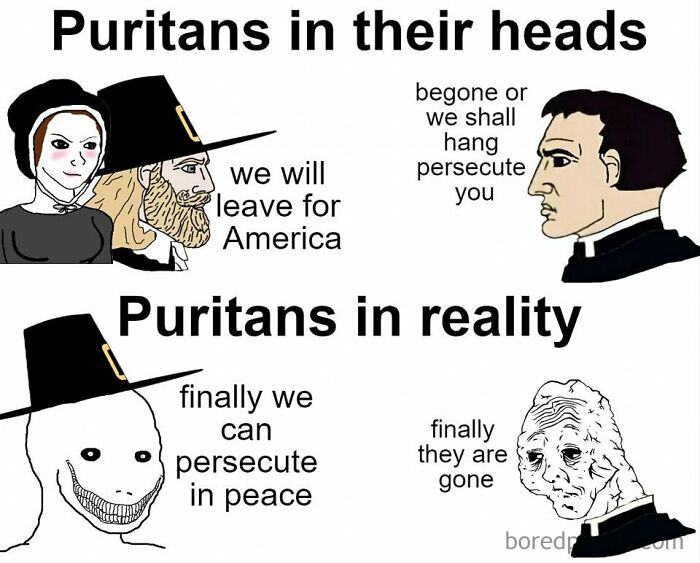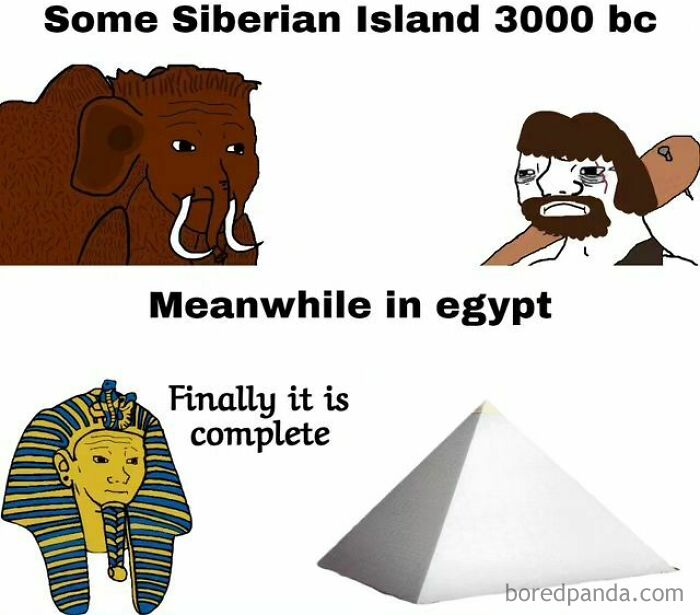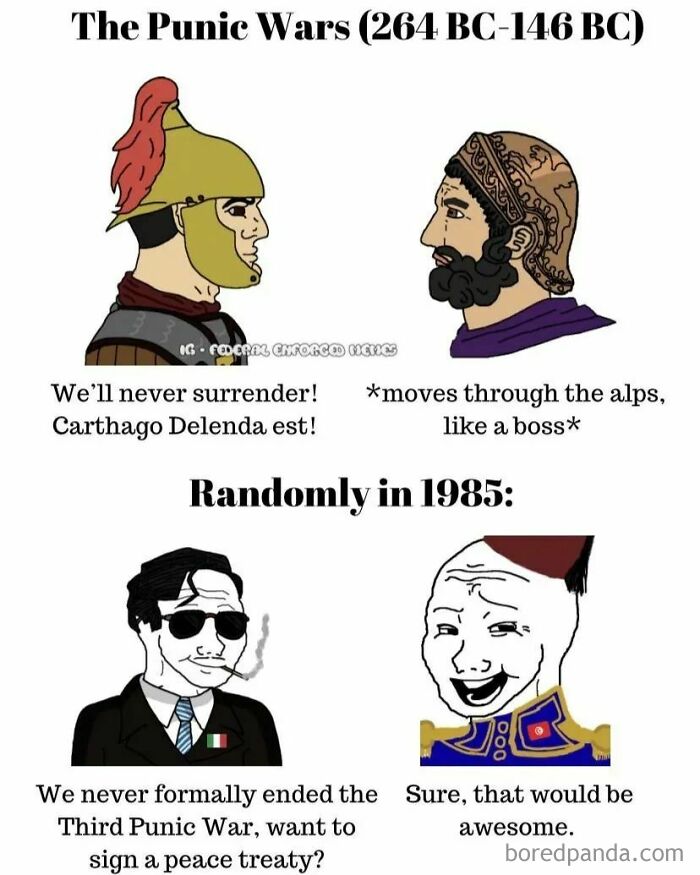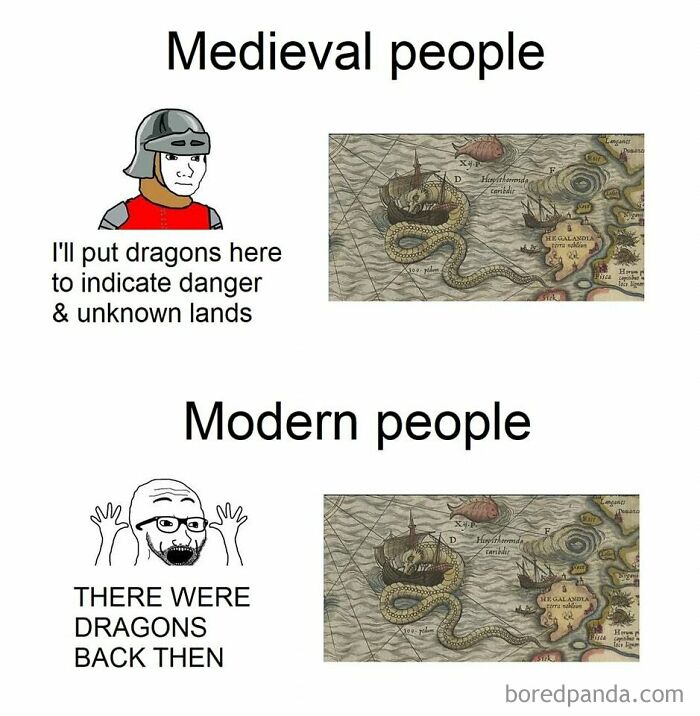When people talk about social media, it is usually presented in a bad light. It makes us feel more insecure, it messes up our attention spans, and it makes us drop our goals for that sweet instant gratification. To put it simply, it is bad in many different proven ways.
However, there are some good things about it, too. One of them is the fact that it provides easy access to information. If we curate our social media feeds responsibly, we can learn from scrolling on our phones.
One such account that is dedicated to spreading knowledge on the internet is Daily Historian on Instagram. There, you will find not only funny memes and pictures but also interesting stories from our history. Scroll down to read our favorite ones.
This post may include affiliate links.
The B.C. and A.D. system is a dating system used to label or number years in the Gregorian and Julian calendars. B.C. stands for "Before Christ," referring to the time before the birth of Jesus Christ, while A.D. stands for "Anno Domini," a Latin phrase meaning "in the year of our Lord," referring to the time after the birth of Jesus Christ. However, it is important to note that scholars later determined that Jesus was born around 6–4 B.C., not A.D. 1. The B.C. and A.D. dating system was not taught in the Bible and was not fully implemented and accepted until several centuries after Jesus' death. B.C.E. and C.E. are alternative dating systems that have gained popularity in recent times. B.C.E. stands for "Before Common Era," and C.E. stands for "Common Era." These terms are equivalent to B.C. and A.D., respectively, but they remove the explicit reference to Christ, making them more inclusive and sensitive to non-Christian beliefs. The use of B.C.E. and C.E. dating system first appeared in the 17th century in German and in the 18th century in English. Today, the use of B.C.E. and C.E. has become fairly common among other groups for similar reasons.
It's worth noting that not every country uses CE/BCE. In Nepal for example it's the year 2080. In Thailand it's 2566 Buddhist Era.
Informational social media accounts might be perceived as simply entertaining and not really having a lasting value, but they do offer us an opportunity at microlearning.
Microlearning is an educational approach that encourages people to learn things in small, focused portions. This type of approach not only increases information retention, but also helps students build confidence in their knowledge.
In 1254, Möngke Khan, the grandson of Genghis Khan, hosted a religious debate between Christian, Muslim, and Buddhist theologians. Möngke Khan was known for his religious pluralism and had a keen interest in learning about different religions. The debate was organized similarly to wrestling matches, with a panel of judges overseeing it, including a Christian, a Muslim, and a Buddhist. A large audience gathered to watch the event, which began with great seriousness and formality. The debate covered various topics such as evil versus good, God's nature, the fate of animal souls, the existence of reincarnation, and whether God created evil. The clerics formed shifting coalitions among the different religions according to the topic being discussed. Between each round of the debate, the participants were required to drink alcohol as well. This led to the debaters becoming increasingly intoxicated, and ending with the Buddhists sitting silently while the Christian and Muslim debaters sang loudly at each other.
Historical empathy refers to the ability to understand and appreciate the thoughts, feelings, and experiences of people from different historical periods and cultures. It involves setting aside our own personal opinions and judgments to better comprehend the motivations, beliefs, and actions of individuals or groups in the past. As someone who studied history as an undergrad, this skill is essential for students of the field. It allows them to engage in historical inquiry and develop a deeper understanding of historical contexts. Historical empathy is not about feeling sorry for historical figures or sympathizing with their points of view. Instead, it is an attempt to understand their perspectives and the reasons behind their actions. This process involves two main components: historical contextualization and perspective-taking. Historical contextualization involves situating events and people within their broader historical context, while perspective-taking requires understanding the mentality, beliefs, values, and intentions of historical agents. In the classroom, historical empathy can be used to help students engage with history and process their own roles in the world today. By understanding people in the past and contextualizing their actions, students can better comprehend how the past has shaped the present and consider the impact of their choices on their own lives and communities.
Microlearning is characterized by a few qualities. The most important one of them is, of course, the amount of the information presented. It is quite brief, only delving into one specific area and allowing the learners to walk away fully understanding it.
Al Capone, the infamous American gangster, is often credited with popularizing expiration dates on milk bottles in the 1930s. The story goes that one of Capone's family members got sick after drinking expired milk, which led Capone to take an interest in the milk industry. He bought a milk processor called Meadowmoor Dairies and lobbied the Chicago City Council to pass a law requiring visible date stamps on milk containers. However, there are alternative theories about Capone's involvement in the milk industry. Some reports suggest that he was looking for a legitimate business to fund his lifestyle after the end of Prohibition. It is believed that all stamping equipment for milk expiration dates was under his control, and after Chicago passed the law mandating visible expiration dates on milk bottles, Capone had the ability to effectively control the local milk market.
The story goes that in his later years Capone realized he could have made more money selling milk than booze. Crime DOES pay but mostly it doesn't pay as well as legitimate business.
During the D-Day landings in June 1944, the captain of the USS Texas intentionally flooded the ship's hull to achieve a specific goal. The Allied forces had advanced inland, and the battleship's guns couldn't aim high enough to reach their intended targets due to insufficient elevation. To overcome this limitation, the crew flooded the starboard torpedo blister, a sponson on the hull below the waterline, causing the ship to list two degrees to starboard. This additional angle allowed the battleship's guns to fire accurately and complete the mission, providing crucial support to the invasion forces. This daring move was unconventional, but it demonstrated the spirit of the Allied forces during the Normandy operation and contributed to the overall success of the invasion.
Henry Avery was an English pirate who operated in the Atlantic and Indian Oceans in the mid-1690s. He was born around 1653 in Cattedown, Plymouth, England. Avery began his career at sea, following in his father's footsteps, and eventually joined the Royal Navy, serving as a midshipman on the HMS Kent and HMS Rupert. Avery's pirate career started when he was the first mate aboard the warship Charles II. The crew mutinied due to unpaid wages and Avery was elected captain of the newly renamed pirate ship, the Fancy. In 1695, Avery and his crew captured a treasure ship of the Mughal emperor, which carried cargo worth over $95 million today. This heist made Avery one of the most successful pirates in history and earned him the nickname "Long Ben". His exploits captured the public's imagination, inspired others to take up piracy, and spawned works of literature. Despite the large bounties offered for his capture, Avery managed to evade arrest and was never caught. His ultimate fate remains a mystery, with some legends suggesting that he lost his fortune to unscrupulous merchants and died in poverty in England. Others believe he made a clean getaway and retired with his loot. Regardless of his fate, Henry Avery remains one of the most notorious and successful pirates in history.
American modern day pirates: steals billions and hides them in overseas banks.
Another feature is that it often uses different forms of multimedia to convey the message. This can be a short-form video, a picture, a quiz, or a game. This enhances the learning experience, making it more fun and engaging. The entertainment aspect helps learners to better retain the information.
The Cobra Bounty in British India refers to an incident during the British colonial rule in India when the British government, concerned about the number of venomous cobras in Delhi, offered a bounty for every dead cobra. The intention was to reduce the cobra population and make the city safer. Initially, the strategy seemed successful, as large numbers of snakes were k***ed for the reward. However, enterprising individuals began breeding cobras to profit from the bounty system. When the British authorities realized this, they canceled the bounty program. As a result, the cobra breeders released their now-worthless snakes into the wild, causing the wild cobra population to increase even further. This incident is often cited as an example of the Cobra Effect, which refers to the unintended negative consequences of an incentive that was designed to improve society or individual well-being. The term was coined by economist Horst Siebert based on this anecdote.
The Puritans were a group of English Protestants in the 16th and 17th centuries who sought to purify the Church of England of Roman Catholic practices. They believed in a covenant relationship with God, and their teachings were heavily influenced by Calvinist theology. They saw themselves as the elect chosen by God to live godly lives both as individuals and as a community. Despite being persecuted for their religious beliefs in England, the Puritans, once in control in New England, did not extend the religious freedom they sought to others. They supported the Old World theory that sanctioned religious uniformity in the state. They expelled dissenters from their colonies, including notable figures like Roger Williams and Anne Hutchinson. Those who defied the Puritans by persistently returning to their jurisdictions risked capital punishment. The Puritans' intolerance was rooted in their belief that they were practicing the only true religion, and therefore everyone should be forced to worship as they did. Ministers like the Reverend John Cotton preached that it was wrong to practice any religion other than Puritanism. Those who did would be helping the devil. However, the Puritans' ability to enforce a single religion in their colonies was short-lived. Not only did Quakers, Baptists, and other non-Puritans move in, but when Charles II came to the throne in 1660, he turned a dark eye on Congregationalism, spelling the eventual end of its religious domination in New England.
Marcus Licinius Crassus, a wealthy Roman businessman and a member of the first Triumvirate along with Pompey and Julius Caesar, died in 53 BC during the Battle of Carrhae. His death is shrouded in mystery and legend, with various accounts of his demise. One account suggests that Crassus was k***ed in a scuffle, possibly by a man named Pomaxathres. Another account states that Crassus was k***ed after refusing to surrender to the Parthians. According to this version, Crassus was wounded in the battle and attempted to negotiate with the Parthians. However, the Parthian general, Surena, ordered that Crassus be k***ed, and his head was cut off and brought to the Parthian king. Yet another account suggests that Crassus was enticed to parlay with Surenas and was k***ed during this meeting. His head and hand were then sent to Orodes II, the Parthian king. There is also a rich set of myths surrounding Crassus's death. One such myth suggests that the Parthians poured molten gold into his mouth, symbolizing the futility of his greed. This account is also supported by other sources, which state that Crassus was k***ed shortly after the Battle of Carrhae by the Parthians who, according to Roman tradition, poured liquid gold into his throat. Regardless of the exact circumstances of his death, Crassus's demise had significant political implications.
A big part of microlearning is how flexible it is. You do not need to follow a specific timeline for learning. You learn at your own pace as long as you have a device that allows you to access the information.
Pope John Paul II is said to have given his blessing to the Pokémon franchise in 2000. The main reasons for this were that he believed the games did not have "any harmful moral side effects" and were based on "ties of intense friendship." The Vatican-based satellite TV station, Sat2000, which was run by the Italian Bishops' Conference, also described the game as "full of inventive imagination." The station further noted that Pokémon encourages its young players to think creatively to overcome challenges without resorting to violence. It was also mentioned that the game tells simple stories that allow children to immerse themselves directly into the story through role-playing adventures.
It's a franchise about capturing wild animals and forcing them to fight for our entertainment. If you replace Pokemon with different breeds of dog you suddenly have a very illegal and cruel activity.
Land reclamation plays a significant role in the history of the Netherlands, which has a long and ongoing struggle against the sea. The primary reason for land reclamation in the Netherlands is the country's unique geography. A large part of the Netherlands is below sea level, making it vulnerable to floods and storms. The earliest recorded land reclamation in the Netherlands dates back to the 11th century when farmers in the coastal regions began to build dikes to protect their farmland from the constant threat of flooding. In the 17th century, the Dutch took land reclamation to a whole new level with the creation of polders. A polder is a low-lying area that has been surrounded by dikes and drained of water, creating new land that can be used for agriculture or development. By the end of the 17th century, over 200,000 hectares of land had been reclaimed in this way. One of the most significant projects was the draining of the Haarlemmermeer, a large lake near Amsterdam, which took 30 years to complete.
Dogs were highly valued in ancient Rome, as they were in other cultures, and the Roman dog served many of the same purposes as it did in other cultures, such as hunting, guarding, and companionship. The Romans created their own artistic dog collars, some of which were made of gold, and they were considered the best protection against ghosts or evil spirits. The Romans viewed dogs far more pragmatically than other cultures, and their treatment of dogs was more grounded. They cared for them as they would family members and honored them when they died with tombs and epitaphs. The swift Laconian (Spartan) and the powerful Molossian were the best-known canine breeds mentioned by classical authors, both of which were native to Greece and used by the Romans for hunting and to watch over the house and livestock. Hounds from Celtic Britain were also famous and exported to Rome even before the conquest. Dogs, and their wolf-ancestors, had a long history with the Romans, as evidenced by the famous tale of the mythical founders of the city, Romulus and Remus, who were said to have been suckled by a she-wolf as infants before they were found and raised by a shepherd.
A good example of microlearning can be a science-oriented TikTok or YouTube page, like one that Hank Green has. Apps like Duolingo are also considered microlearning tools as they gamify language learning. You could also consider checking out a 'word' or 'fact of the day' as a type of microlearning. Which is why informational social media accounts are up there, too.
Leonardo da Vinci dissected corpses to gain a deeper understanding of the human body for both his art and scientific pursuits. He believed that understanding the human body's structure and function would help him create more realistic and accurate art. Da Vinci was also fascinated by the human body as a creation of nature and sought to comprehend its physical workings. Though he lacked formal medical training, da Vinci is believed to have dissected more than 30 bodies in his lifetime. Initially, he dissected animals and later compared their anatomy to that of humans. In the 1500s, as his reputation grew, he was allowed to dissect corpses in medical universities and hospitals. Before this, he had to rely on grave robbers to acquire corpses, as human corpse dissection was legalized only for medical universities and doctors who performed post-mortems. Da Vinci's anatomical drawings were incredibly accurate and detailed, reflecting his meticulous dissections and his skills as a draftsman. His studies of the human body were groundbreaking at the time and contributed significantly to the understanding of human anatomy.
Operation PX was proposed in December 1944 by the Japanese Naval General Staff, led by Vice-Admiral Jisaburō Ozawa. The name for the operation came from the Japanese use of the code name PX for Pestis bacillus-infected fleas. In planning the operation, the navy partnered with Lieutenant-General Shirō Ishii of Unit 731, who had extensive experience on weaponizing pathogenic bacteria and human vulnerability to biological and chemical warfare. The plan for the attack involved Seiran aircraft launched by submarine aircraft carriers upon the West Coast of the United States—specifically, the cities of San Diego, Los Angeles, and San Francisco. The planes would spread weaponized bubonic plague, cholera, typhus, dengue fever, and other pathogens in a biological terror attack upon the population. The submarine crews would infect themselves and run ashore in a s*****e mission. Planning for Operation PX was finalized on March 26, 1945, but shelved shortly thereafter due to the strong opposition of Chief of General Staff Yoshijirō Umezu. Umezu later explained his decision as such: "If bacteriological warfare is conducted, it will grow from the dimension of war between Japan and America to an endless battle of humanity against bacteria. Japan will earn the derision of the world."
Biowarfare is terrifying. We all lived through 2020. COVID was just a natural epidemic. A man made epidemic is even more terrifying.
All of that to say that we are learning all the time, taking in information from our surroundings. Choosing to subscribe to informational content is a step towards more knowledge. Just remember to carefully curate what you read and only listen to reliable information.
The Argentine Poodle Incident refers to a tragic event that occurred on October 21, 1988, in Buenos Aires, Argentina. A poodle named Cachi fell from a 13th-floor balcony and landed on a 75-year-old woman named Marta Espina, k***ing both the woman and the dog instantly. The incident led to two more deaths. A second woman was k***ed after a bus hit her as she came to see what had happened. An unidentified man who witnessed the second woman's death had a heart attack and died on the way to the hospital. The incident began when Cachi was playing with a tennis ball in the Montoya family's apartment. The ball bounced too far, and Cachi chased it onto the balcony, eventually falling through the railings to the street below.
The Aztecs followed the Spanish around with incense burners when they arrived in Mexico. The Spaniards believed this to be a divine honor, but it was actually a necessity due to the wide gap in hygiene between the two peoples. The Aztecs used a variety of deodorants, including flowers and oils, whereas incense was used in different ritual contexts. The Spaniards' smell was so unbearable to the Aztecs that they used their ritual incense to mask it. The Aztecs were known for their cleanliness and personal hygiene, and they bathed often, and many of them every day in the rivers, lakes, or pools. The Spaniards' hygiene was poor, and they were unable to stay clean in the conditions they were in.
The Aztec city of Tenochtitlan was far cleaner than any European city at that time. The accounts by the initial Spanish explorers describe a clean, technologically-advanced city with clean, paved streets; Europeans were still throwing the contents of their chamber pots onto mud streets.
Medieval monks played a significant role in the development of cheese and wine production techniques. They created various types of cheese and wine, which were essential for their diet and religious practices. Monks from different orders, such as Benedictines, Cistercians, Trappists, Franciscans, and Dominicans, created many legendary cheeses in Europe. Monastic and Benedictine houses were particularly involved in commercial cheese production, selling surplus stock. In England, for example, the Abbey of St. Albans had a rich monastic tradition in cheesemaking. Monks also developed "Monastery Cheeses" by washing the rinds of their cheeses with fermented, brewed drinks like abbey ales. Wine was essential for religious rites and was also a staple of the monks' diets. Monasteries and abbeys ventured into winemaking to ensure a steady supply of wine. Monks from the Benedictine and Cistercian orders, in particular, played a prominent role in the development of winemaking. They experimented with different grape varieties, winemaking techniques, and landscape management to improve the quality of their wines. In Burgundy, monks were responsible for maintaining winemaking knowledge and skills during the turbulent Middle Ages. In Champagne, the Benedictine monk Dom Pierre Pérignon introduced several viticulture and winemaking techniques in the 17th century.
The British and French were the first to develop tanks in World War I, with the goal of creating armored vehicles capable of crossing trenches, breaking through barbed wire, and providing protection for infantry. The first tank used in battle was the British Mark I, which made its debut during the Battle of the Somme in September 1916. The Mark I was a large, slow-moving vehicle with a rhomboidal shape, designed to cross trenches and crush barbed wire. It was armed with machine guns and/or cannons, depending on the variant. Although the Mark I had a dramatic effect on German morale and proved effective in crossing trenches and wire entanglements, it failed to break through the German lines. The French also developed tanks during World War I, with the first model being the CA 1. Later in the war, the French car company Renault produced the Renault FT, which became a more successful design. The German army also began to develop their own tanks as the war progressed. Early tanks faced several challenges, including slow speed, mechanical malfunctions, and vulnerability to enemy fire. Despite these issues, tanks played a significant role in World War I and contributed to the development of modern armored warfare.
In 1985, a symbolic peace treaty was signed between Italy and Tunisia, representing the modern cities of Rome and Carthage, respectively. The treaty was signed by Ugo Vetere, the mayor of Rome, and Chedli Klibi, the mayor of modern Carthage, on February 5, 1985. This event took place 2,131 years after the end of the Third Punic War, which was fought between Rome and Carthage from 149 to 146 BC. The signing of the peace treaty was a symbolic gesture to reinforce the relationship between Italy and Tunisia and to promote friendship and cooperation between the two cities. The Punic Wars were a series of three wars fought between Rome and Carthage from 264 to 146 BC. The First Punic War (264–241 BC) was primarily fought over the control of Sicily, with Rome emerging victorious and Carthage ceding Sicily and the Lipari Islands to Rome. The Second Punic War (218–201 BC) saw the famous Carthaginian general Hannibal crossing the Alps and invading mainland Italy, but ultimately, Rome defeated Carthage again. The Third Punic War (149–146 BC) resulted in the complete destruction of Carthage, the enslavement of its population, and Roman hegemony over the western Mediterranean.
The death of Samuel Morse's wife, Lucretia, had a significant impact on his motivation to create the telegraph. In February 1825, Morse was in Washington, D.C., working as a painter when his wife suddenly died at the age of 25. His father sent him a letter with the sad news, but due to the slow communication methods of the time, Morse did not receive it for several days. By the time he returned home to New Haven, Connecticut, his wife had already been buried. This personal tragedy inspired Morse to explore faster ways of communication. He wanted messages, like the news about his wife, to reach people more quickly and efficiently. This led him to develop the telegraph, which revolutionized long-distance communication by transmitting electrical signals over a wire laid between stations. Morse, along with Joseph Henry and Alfred Vail, invented an electrical telegraph system in 1836. The invention of the telegraph and the development of Morse code allowed for the simple transmission of complex messages across telegraph lines, significantly improving communication speed and efficiency.
The common narrative is that the USA was forced to use nuclear weapons. A realistic non nuclear resolution was possible. Operation Downfall was planned. We'll never know how that scenario would have played out. There's no point in arguing about it now, the decision was made almost 80 years ago. I recommend the HBO miniseries "Hiroshima" for context.
The Tuskegee Syphilis Study was a research experiment conducted by the U.S. Public Health Service and the Tuskegee Institute in Alabama between 1932 and 1972. The study aimed to observe the natural history of untreated syphilis in 600 Black men, 399 of whom had syphilis and 201 who did not have the disease. Participants were not informed about their diagnosis or the true purpose of the study. They were told they were being treated for "bad blood," a local term used to describe various ailments, including syphilis, anemia, and fatigue. In exchange for participating in the study, the men received free medical exams, meals, and burial insurance. The study continued even after penicillin became the recommended treatment for syphilis in 1947. Researchers did not offer treatment to the participants and convinced local physicians not to treat them either. The study was finally terminated in 1972 after it was exposed in the media, leading to public outrage and significant changes in research practices and ethical standards.
The P-59 Airacomet was the first operational jet-powered fighter aircraft used by the United States Army Air Forces (USAAF) during World War II. The first pilot of the P-59 was none other than Bell Aircraft Corporation's test pilot, Robert Morris Stanley. On October 2, 1942, Stanley was to make the first flight of the P-59. However, there was a catch - the USAAF had requested that Stanley wear a gorilla suit during the flight. The reason behind this strange request was to maintain secrecy. At the time, the development of jet engines was top secret, and the USAAF wanted to keep the P-59 project under wraps. So, they requested that Stanley wear a gorilla suit during the flight to make it appear as if the aircraft was being flown by a "crazy" pilot. The idea was that if anyone saw the aircraft flying, they would think it was a stunt or joke, rather than a top-secret military aircraft. Stanley complied with the request and donned the gorilla suit before climbing into the cockpit of the P-59. The flight was a success, and the P-59 went on to become the first operational jet-powered fighter aircraft used by the USAAF. The gorilla suit incident has since become a footnote in aviation history, but it serves as a reminder of the extreme measures taken during World War II to protect military secrets.
Not the craziest thing the allies did for secrecy during that war. Look uo "The Man Who Never Was".
Some Medieval maps used dragons to indicate unknown or dangerous areas as a way to represent the uncharted territories and the potential dangers that explorers might encounter. This practice is thought to be rooted in the Christian tradition, where dragons were associated with evil and Satan. Examples of dragons on historical maps include: -The Fra Mauro Map (c. 1450 AD): This map shows the "Island of Dragons" (Italian: Isola de' dragoni), an imaginary island in the Atlantic Ocean. Near Herat in modern-day Afghanistan, the map mentions dragons with stones in their foreheads that cure infirmities. -The T-O Psalter map (c. 1250 AD): This map features dragons as symbols of sin in a lower frame below the world, balancing Jesus and angels on the top. However, the dragons do not appear on the map proper. -The Borgia map (c. 1450 AD): A world map engraved on a metal plate, featuring a drawing of a dragon on its peripheral near the area that depicts Asia.
J. Robert Oppenheimer, known as the "Father of the Atomic Bomb," played a crucial role in the development of the atomic bomb during World War II. After the bombings of Hiroshima and Nagasaki, Oppenheimer expressed his guilt and remorse over the devastating consequences of the bomb. In a meeting with President Harry Truman in October 1945, Oppenheimer famously claimed to have "blood on his hands." This comment infuriated Truman, who believed that the responsibility for the bombings was his alone as the president. Truman's anger towards Oppenheimer's remark led to a strained relationship between the two. In later years, Truman would retell and embellish the story of their meeting, claiming that he sarcastically offered Oppenheimer a handkerchief to wipe his hands. Truman referred to Oppenheimer as a "cry baby scientist" and would never trust him again. Despite Oppenheimer's efforts to prevent the development of more powerful nuclear weapons, such as the hydrogen bomb, his opposition to the project and his alleged Communist ties led to his dismissal from the U.S. Atomic Energy Commission during the McCarthy era. Truman's decision to dismiss Oppenheimer was influenced by his concerns about the prospect of Soviet nuclear development and his belief that the responsibility for the bombings was solely his own.
I really like this story. It asks the question "Who is guilty of the murder?" The man who made the gun or the man who pulled the trigger? If only gun manufacturers and gun sellers had an ounce of Oppenheimer's remorse.
Taxation in medieval Europe was administered in various ways, depending on the region and the type of tax. In general, taxes were levied on land, trade, and movable property, and were collected by different authorities, such as the king, feudal lords, and the Church. In medieval England, the main form of taxation was land taxes, such as the geld, which was first regularly collected in 1012. The geld was unique in Europe at the time, as it was a universal land tax on all the king's subjects, not just his immediate feudal tenants and peasants. It was assessed on the hide, and the usual rate was 2 shillings per hide. In the 13th century, as people became rich from trade rather than land, kings began to impose taxes on trade. For example, King Edward I taxed every sack of wool that was exported to other countries. Taxes were also imposed on movable property, with people having to pay a percentage of their property's value (usually about 10%) to the king. Feudal lords could ask their vassals for an aid, a tax paid by persons or communities to someone in authority. Aids were limited to specific occasions, such as the knighting of the lord's eldest son, the first marriage of his eldest daughter, the payment of his ransom, or his going on a crusade. In addition, the lord of the manor could demand a taille, a tax from the inhabitants of his domain, which developed into the royal taille or tallage, a direct tax levied by sovereigns. Tax collection was often delegated to local governments or private tax collectors. In medieval Paris, the taille was an institution that resolved the tax compliance problem by turning the social cost of tax evasion into a private one.
The Walcheren Campaign was an unsuccessful British expedition to the Netherlands in 1809, intended to open another front in the Austrian Empire's struggle with France during the War of the Fifth Coalition. The campaign had two main objectives: capturing Flushing and Antwerp in the Netherlands and enabling navigation of the Scheldt River. The commander of the expedition was Sir John Pitt, 2nd Earl of Chatham. The campaign involved a large British force of 39,000 soldiers, 15,000 horses, and 616 ships. Despite the size of the force, the campaign failed to achieve its objectives and was plagued by disease, with over 4,000 British troops dying during the expedition, and only 106 of them dying in combat. The survivors withdrew on December 9, 1809. The Walcheren Campaign was a disaster for several reasons: 1. Poor timing: The British force landed after the Austrians had already been defeated, which meant that the campaign's goal of assisting Austria was no longer relevant. 2. Slow progress: The British army advanced too slowly, allowing the French to reinforce Antwerp and preventing the British from capturing i. 3. Poor communication: There was poor communication between the British military and naval commanders, which hindered the coordination of their efforts. 4. Disease: The campaign was severely affected by the outbreak of "Walcheren fever," which struck down a quarter of the entire army within three weeks. This fever was likely a combination of malaria, typhus, typhoid, and dysentery.
England has never had any luck with invading the Netherlands. Google up "Operation Market Garden".
Wow a lot of these a flat out, and I mean FLAT OUT F*****G WRONG, and a lot of propaganda. Like I said history is written by the winners.
History isn't written by the winners. The Jewish people for instance have written a lot of history as the losers. At Gallipoli it was the losers who wrote the history.
Load More Replies...Wow a lot of these a flat out, and I mean FLAT OUT F*****G WRONG, and a lot of propaganda. Like I said history is written by the winners.
History isn't written by the winners. The Jewish people for instance have written a lot of history as the losers. At Gallipoli it was the losers who wrote the history.
Load More Replies...
 Dark Mode
Dark Mode 

 No fees, cancel anytime
No fees, cancel anytime 






























































































































